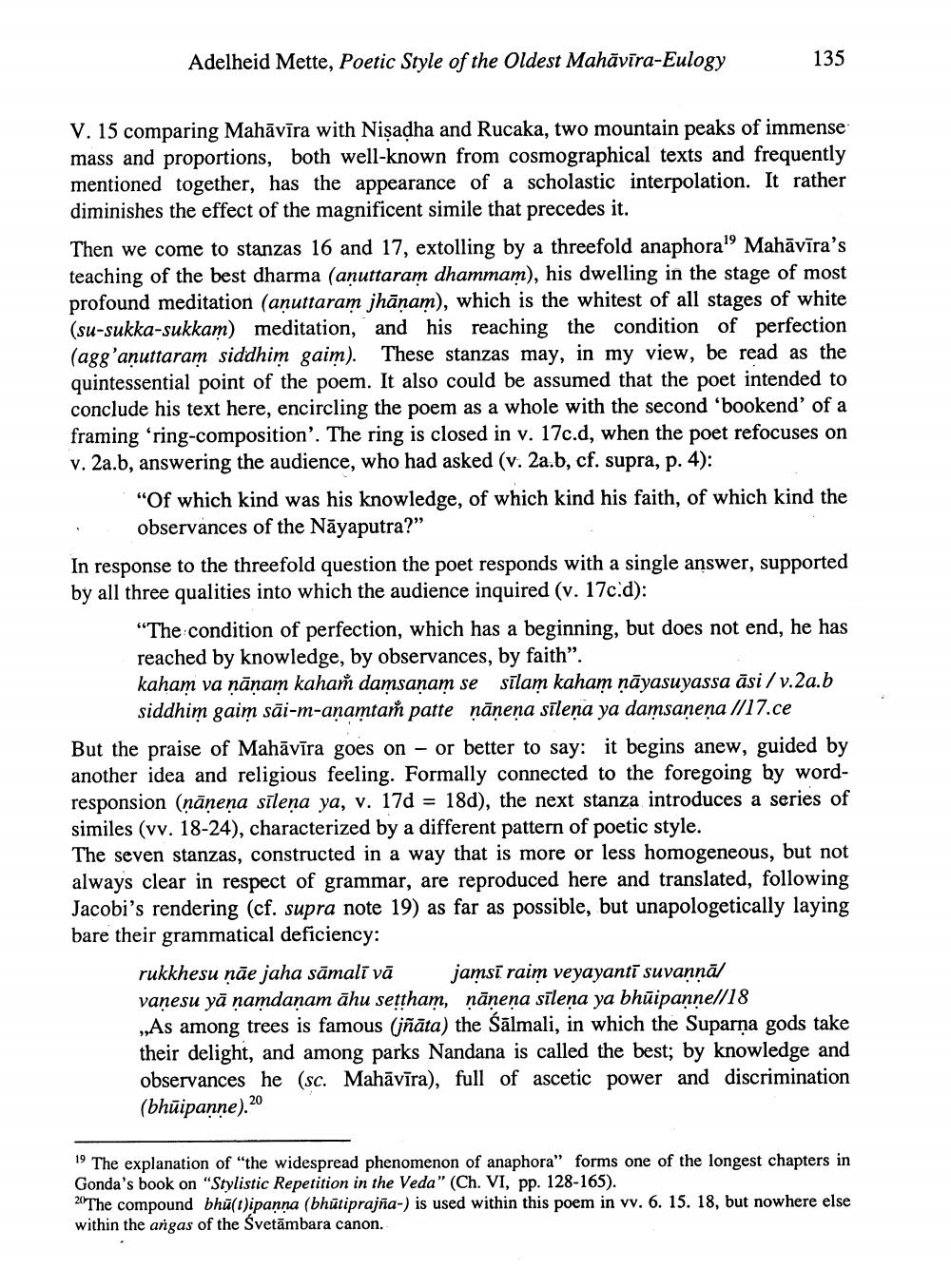________________
Adelheid Mette, Poetic Style of the Oldest Mahāvīra-Eulogy
135
V. 15 comparing Mahāvīra with Niṣadha and Rucaka, two mountain peaks of immense mass and proportions, both well-known from cosmographical texts and frequently mentioned together, has the appearance of a scholastic interpolation. It rather diminishes the effect of the magnificent simile that precedes it.
Then we come to stanzas 16 and 17, extolling by a threefold anaphora" Mahāvīra's teaching of the best dharma (anuttaram dhammam), his dwelling in the stage of most profound meditation (anuttaram jhāṇam), which is the whitest of all stages of white (su-sukka-sukkam) meditation, and his reaching the condition of perfection (agg'aṇuttaram siddhim gaim). These stanzas may, in my view, be read as the quintessential point of the poem. It also could be assumed that the poet intended to conclude his text here, encircling the poem as a whole with the second 'bookend' of a framing 'ring-composition'. The ring is closed in v. 17c.d, when the poet refocuses on v. 2a.b, answering the audience, who had asked (v. 2a.b, cf. supra, p. 4):
"Of which kind was his knowledge, of which kind his faith, of which kind the observances of the Nayaputra?"
In response to the threefold question the poet responds with a single answer, supported by all three qualities into which the audience inquired (v. 17c.d):
"The condition of perfection, which has a beginning, but does not end, he has reached by knowledge, by observances, by faith".
kaham va ṇāṇam kahaṁ damsanam se silam kaham ṇāyasuyassa äsi/v.2a.b siddhim gaim säi-m-anamtam patte nänena silena ya damsanena //17.ce
But the praise of Mahāvīra goes on or better to say: it begins anew, guided by another idea and religious feeling. Formally connected to the foregoing by wordresponsion (näṇeņa silena ya, v. 17d 18d), the next stanza introduces a series of similes (vv. 18-24), characterized by a different pattern of poetic style.
The seven stanzas, constructed in a way that is more or less homogeneous, but not always clear in respect of grammar, are reproduced here and translated, following Jacobi's rendering (cf. supra note 19) as far as possible, but unapologetically laying bare their grammatical deficiency:
rukkhesu näe jaha sämalī vā jamsi raim veyayanti suvaṛṇā vanesu ya namdanam ahu seṭṭham, nänena silena ya bhüipanne//18
As among trees is famous (jñāta) the Sälmali, in which the Suparna gods take their delight, and among parks Nandana is called the best; by knowledge and observances he (sc. Mahävira), full of ascetic power and discrimination (bhūipanne),20
19 The explanation of "the widespread phenomenon of anaphora" forms one of the longest chapters in Gonda's book on "Stylistic Repetition in the Veda" (Ch. VI, pp. 128-165).
20The compound bhu(t)ipanna (bhutiprajña-) is used within this poem in vv. 6. 15. 18, but nowhere else within the angas of the Svetambara canon.




